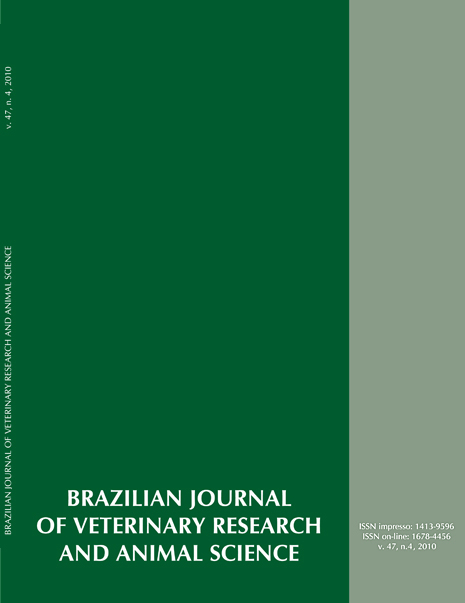A semi-nested RT-PCR assay targeted to hemagglutinin-esterase gene of Bovine Coronavirus
DOI:
https://doi.org/10.11606/issn.1678-4456.bjvras.2010.26832Keywords:
Bovine coronavirus, RT-PCR, Hemagglutinin-esterase, Genetic diversityAbstract
Bovine coronavirus (BCoV) is a non-segmented positive-sense single-stranded RNA virus whose envelope is constituted by a lipid bilayer with four structural proteins (HE, S, E and M) giving its characteristic crown-like virions appearance. Hemagglutinin-esterase (HE), is a polymorphic protein with a function of secondary receptor binder, and studies on the diversity of HE gene allow insights on BCoV evolution and host-parasite interactions. A semi-nested RT-PCR was developed for the amplification of a 441bp-long product of the HE gene of BCoV (nt 543 to 562). Optimal annealing temperatures were tested in a gradient thermocycler for the semi-nested assay and employed in the final protocol. The analytical sensitivity was determined by 10-fold serial dilutions of the BCoV Kakegawa strain (HA titer: 256) in a BCoV-free fecal suspension, with positive results up to 10-6 dilution, a high analytical sensitivity without PCR inhibition. The final semi-nested RT-PCR protocol was applied to 21 fecal samples of cows previously positive to BCoV and DNA sequencing of the 441bp amplicons of 14 of these resulted in highly-scored BCoV HE gene sequences after BLAST/n analysis. This semi-nested RT-PCR is a powerful tool for surveys of phylogenetic diversity in field strains of BCoV and for comparative studies among different genes of Coronavirus.Downloads
Downloads
Published
2010-08-01
Issue
Section
UNDEFINIED
License
The journal content is authorized under the Creative Commons BY-NC-SA license (summary of the license: https://
How to Cite
1.
Souza SP de, Asano KM, Buitrago LYV, Silva S de OS, Richtzenhain LJ, Brandão PE. A semi-nested RT-PCR assay targeted to hemagglutinin-esterase gene of Bovine Coronavirus. Braz. J. Vet. Res. Anim. Sci. [Internet]. 2010 Aug. 1 [cited 2025 Apr. 5];47(4):323-8. Available from: https://revistas.usp.br/bjvras/article/view/26832





